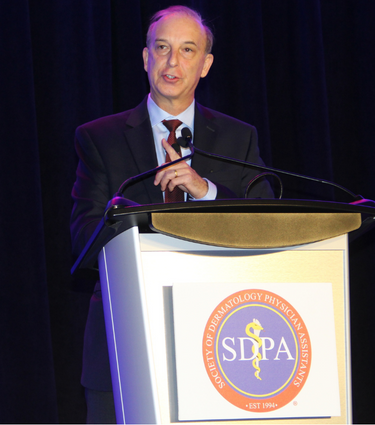Healing the Unhealable Wound
Wounds affect about six million Americans each year, with associated healthcare costs estimated at about $40 billion, Miami physician Robert S. Kirsner, PhD, said during an enlightening presentation at SDPA’s fall conference in November 2022. An algorithmic approach to wound care in patients begins with identifying what type of wound, or ulcer, is present with the most common presentations being diabetic foot ulcers and venous leg ulcers.
Coverage: SDPA 20th Annual Fall Dermatology Conference Nov. 17-20, 2022, in Miami
When a wound is uncommon in presentation, a biopsy, culture and labs are recommended to help identify the lesion. When biopsying an ulcer, Dr. Kirsner recommends taking a sample from both the middle and the edge of the wound. Once the type of wound is identified, the next step is to perform a vascular exam, followed by a trial of treatment. Uncommon wound presentations may have an atypical appearance or atypical location. Dr. Kirsner reviewed cases of uncommon presentations with attendees, including malignancies such as basal cell cancer, malignant melanoma and a giant ulcerating squamous cell cancer arising from a linear porokertatosis. Additional diagnoses to keep on the differential include vasculitis, pyoderma gangrenosum, autoimmune disease, parafinomas, localized bullous pemphigoid and herpes simplex virus (HSV).
The vascular evaluation of the patient is important because vascular disease increases the risk of amputation, myocardial infarction (MI), stroke and death. In addition to palpation of pedal pulses, Dr. Kirsner reviewed ankle-brachial index (ABI) and vascular perfusion studies. Typical features of diabetic foot ulcers include surrounding callus, bone deformities, neuropathic pain and plantar location. In addition to vascular evaluation, it is important to assess for neuropathy with a monofilament. Treatment of diabetic foot ulcers focuses on offloading and redistributing pressure. As less than a quarter of patients wear their prescribed offloading devices, it is best to find a way to give them an instant total contact cast which can be accomplished through applying Coban around offloading devices. Measuring wound size is important to evaluate for wound improvement as failure to improve within the first four weeks with a treatment trial predicts long-term treatment failure. Dr. Kirsner concluded his lecture by reviewing topical and oral agents, which may help in wound healing.
Byline: Sarah B.W. Patton, PA-C
Pictured: Robert S. Kirsner, MD, PhD, Department of Dermatology and Cutaneous Surgery, University of Miami
